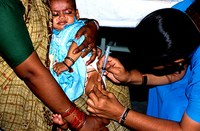 Reddy spoke on the final day of the TWAS 21st General Meeting in Hyderabad.
Reddy spoke on the final day of the TWAS 21st General Meeting in Hyderabad.
Reddy notes that developing countries "increasingly find themselves facing multiple disease burdens." On the one hand, they must grapple with infectious diseases associated with poverty – for example, bouts of acute diarrhoea, malaria and tuberculosis. On the other hand, they must increasingly deal with lifestyle diseases – for example, hypertension and cardiovascular disease, cancer and diabetes – that are often related to unhealthy diets and sedentary patterns of behaviour previously associated only with wealthy countries.
As Reddy observes, India, which still suffers high rates of infectious diseases, is now the global capital of diabetes. "An estimated 41 million Indians have diabetes," he says, "and that figure is expected to rise between 70 and 80 million people over the next few decades."
"Heart attacks are also on the rise in India," Reddy says. But in contrast to developed countries, where heart attacks first occur between the ages 60 and 70, in India and other developing countries heart attacks often strike in the late 40s or early 50s.
How can any country, Reddy asks, hope to build a prosperous society when a disproportionate number of its citizens are debilitated by illness and disease during the prime years of their work life? He cites a recent World Health Organization study which estimates that, between 2005 and 2015, developing countries will experience economic losses of more than USD235 billion due to heart ailments, strokes and diabetes.
If there is one word that describes the state of global health today, it is 'disparity'. For example, Reddy observes that there are disparities in life expectancy at birth ranging from just over 40 in Lesotho to more than 80 in Japan. There are disparities in maternal mortality rates ranging from 2,000 deaths per 100,000 live births in Sierra Leone to 4 in Austria. And there are disparities in infant mortality rates, ranging from 160 deaths per 1,000 live births in Afghanistan to 3 in Singapore.
Disparities in critical health indicators, Reddy notes, just don't exist between developed and developing countries. They are present among developing countries too. For instance, the maternal mortality rate in India stands at 254 per 100,000 live births. In China, it is 54.
So, what can be done to improve global health and narrow health disparities between countries?
Reddy says that it is important for developing countries to address their chronic shortcomings in medical personnel. Malawi, for instance, has 0.04 doctors per 1,000 population; Cuba has more than 6.
But it's not just personnel shortages, or for that matter money, that requires the attention of policy makers. Reddy says there must also be a fundamental shift in thinking on how to train and employ health professionals.
"Greater emphasis must be placed on primary health care," he maintains, "and that means training greater numbers of general practitioners and fewer specialists." He also contends that "we must move health-care curricula beyond strictly confined professional tracts to channels that provide the knowledge and skills health-care professionals will need to 'fit the functions' that they will be asked to serve."
He asserts that we must increase incentives for results-based, rather than service-based, health-care, and develop comprehensive strategies to take advantage of new technologies, especially information and communication technologies, to improve the efficiency of health-care delivery. New fields of science, such as genomics, must be embraced not just by researchers, but also by clinicians. Yet, he also states that "we must carefully evaluate these technologies and fields" to ensure the investments are paying off in terms of better health.
Reddy observes that the 21st century will be the century of global health, and that this carries two important implications for health-care practices worldwide.
First, it means that a growing number of health issues will require a global response if we are to meet the challenges that these issues entail. These issues include the rapid transmission of new pathogens, fears of bioterrorism and the growing incidences of such non-communicable diseases as tobacco-related cancer, diabetes and obesity that are associated with unhealthy diets and lifestyles.
Second, Reddy notes that health is increasingly affected by trends that "are not often thought to be directly related to health", but that nevertheless have "profound impacts on whether people are able to live healthy lives." These trends, for example, include rapid urbanization and a sharp rise in air pollution levels in cities in developing world, the spread of industrial agriculture which raises the prospects of more frequent occurrences of zootropic pandemics, and the spectre of global warming.
The 19th century, Reddy observes, was marked by the first significant advances in the practice of medicine and the 20th century by a rise in public health concerns.
The 21st century, in contrast, may be the century in which health issues are directly tied to broader currents in our global community, including efforts to combat global warming and devise effective measures for sustainable development.
To meet these complex challenges, Reddy concludes that "we must pursue strategies that have multiple, synergistic benefits for the economy, the environment and public health."

